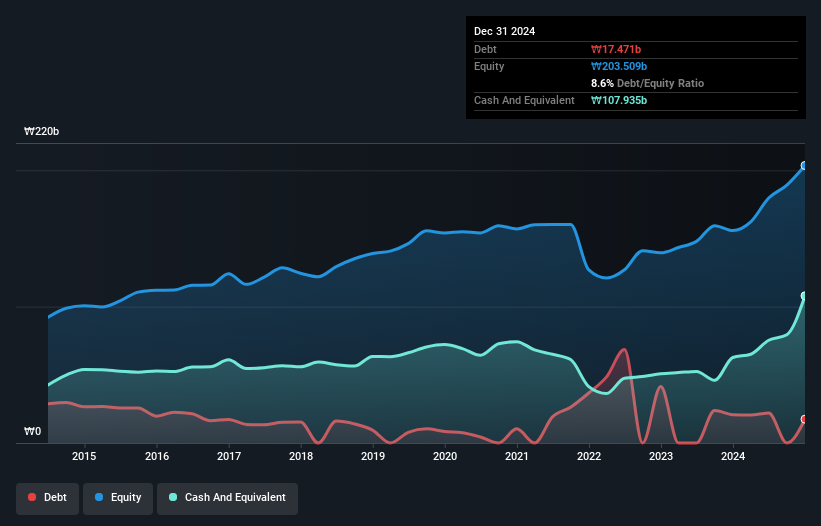Warren Buffett famously said, 'Volatility is far from synonymous with risk.' So it might be obvious that you need to consider debt, when you think about how risky any given stock is, because too much debt can sink a company. We can see that ESTec Corporation (KOSDAQ:069510) does use debt in its business. But is this debt a concern to shareholders?
When Is Debt Dangerous?
Generally speaking, debt only becomes a real problem when a company can't easily pay it off, either by raising capital or with its own cash flow. In the worst case scenario, a company can go bankrupt if it cannot pay its creditors. While that is not too common, we often do see indebted companies permanently diluting shareholders because lenders force them to raise capital at a distressed price. Of course, debt can be an important tool in businesses, particularly capital heavy businesses. When we examine debt levels, we first consider both cash and debt levels, together.
How Much Debt Does ESTec Carry?
As you can see below, ESTec had ₩17.5b of debt at December 2024, down from ₩20.8b a year prior. However, it does have ₩107.9b in cash offsetting this, leading to net cash of ₩90.5b.

How Strong Is ESTec's Balance Sheet?
We can see from the most recent balance sheet that ESTec had liabilities of ₩178.3b falling due within a year, and liabilities of ₩6.12b due beyond that. On the other hand, it had cash of ₩107.9b and ₩152.9b worth of receivables due within a year. So it can boast ₩76.3b more liquid assets than total liabilities.
This luscious liquidity implies that ESTec's balance sheet is sturdy like a giant sequoia tree. Having regard to this fact, we think its balance sheet is as strong as an ox. Succinctly put, ESTec boasts net cash, so it's fair to say it does not have a heavy debt load!
Check out our latest analysis for ESTec
On top of that, ESTec grew its EBIT by 79% over the last twelve months, and that growth will make it easier to handle its debt. When analysing debt levels, the balance sheet is the obvious place to start. But it is ESTec's earnings that will influence how the balance sheet holds up in the future. So when considering debt, it's definitely worth looking at the earnings trend. Click here for an interactive snapshot.
Finally, while the tax-man may adore accounting profits, lenders only accept cold hard cash. While ESTec has net cash on its balance sheet, it's still worth taking a look at its ability to convert earnings before interest and tax (EBIT) to free cash flow, to help us understand how quickly it is building (or eroding) that cash balance. Happily for any shareholders, ESTec actually produced more free cash flow than EBIT over the last three years. There's nothing better than incoming cash when it comes to staying in your lenders' good graces.
Summing Up
While it is always sensible to investigate a company's debt, in this case ESTec has ₩90.5b in net cash and a decent-looking balance sheet. And it impressed us with free cash flow of ₩48b, being 112% of its EBIT. At the end of the day we're not concerned about ESTec's debt. There's no doubt that we learn most about debt from the balance sheet. But ultimately, every company can contain risks that exist outside of the balance sheet. Be aware that ESTec is showing 2 warning signs in our investment analysis , you should know about...
If you're interested in investing in businesses that can grow profits without the burden of debt, then check out this free list of growing businesses that have net cash on the balance sheet.
Valuation is complex, but we're here to simplify it.
Discover if ESTec might be undervalued or overvalued with our detailed analysis, featuring fair value estimates, potential risks, dividends, insider trades, and its financial condition.
Access Free AnalysisHave feedback on this article? Concerned about the content? Get in touch with us directly. Alternatively, email editorial-team (at) simplywallst.com.
This article by Simply Wall St is general in nature. We provide commentary based on historical data and analyst forecasts only using an unbiased methodology and our articles are not intended to be financial advice. It does not constitute a recommendation to buy or sell any stock, and does not take account of your objectives, or your financial situation. We aim to bring you long-term focused analysis driven by fundamental data. Note that our analysis may not factor in the latest price-sensitive company announcements or qualitative material. Simply Wall St has no position in any stocks mentioned.
About KOSDAQ:A069510
ESTec
Manufactures and sells audio equipment in South Korea, Japan, the United States, Europe, and internationally.
Flawless balance sheet, good value and pays a dividend.
Market Insights
Community Narratives




